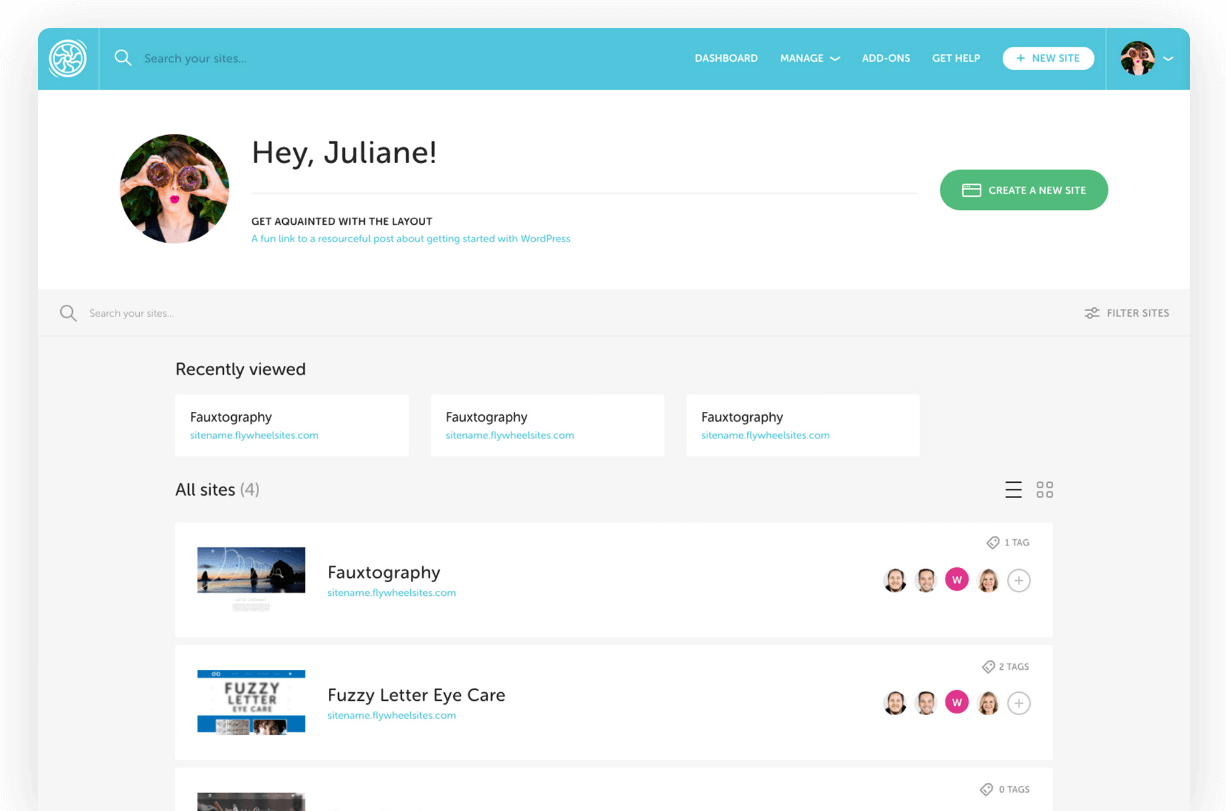Overage pricing
Whether you get an unexpected influx in traffic or you need more storage as you’re adding more content, we want to support the growth of your site! So instead of throttling or shutting off-sites, we charge simple overage fees based on the traffic you received and the storage you’re using.
Visits
At Flywheel, each plan comes with an allotment of visits available during a month. We do not turn off sites or customer plans due to spikes in traffic, or any event that may cause you to receive more visits than your plan allows for.
When your number of visits exceeds your plan limit, we charge a small overage fee for every 1,000 visitors over your limit. The overage cost is $2 per 1,000 extra monthly visitors. For instance, if you are on a Starter plan and receive 35,000 visits that month, you would receive an overage fee of $20.
We track a visit as a unique IP address over a 24-hour period. If the same IP address hits your site 100 times in the same day, it counts as one visit. If the same IP address visits 5 times today and comes back again tomorrow, it counts as two visits. To help ensure accurate visit counts, Flywheel ignores IP addresses from known bots, spammers, and attackers
Note
Does this count as a visit?
-
- A person arrives at your site and loads a page: Yes, that counts as a visit.
- That same person clicks a link that opens another page on the same site: No, that’s the same IP address, it won’t be counted as a second visit.
- That same person loads your site in a different browser: No because they are still accessing the site from the same IP address.
- That same person goes into their office and loads your site: Yes because they are accessing the site from a new IP address.
- That same person visits your site a week later: Yes, because Flywheel resets visits every 24 hours.
Storage
Each plan comes with a limit on the amount of storage (files and databases) that your plan allows for. We do not set hard limits on storage and your sites will not go down if you exceed your limit. Instead, we charge storage overage fees as well.
When your storage exceeds your limit, we charge an additional $1 for every GB you are over your limit. For instance, if you are on an Agency plan and are using 75GB of storage, you’d receive an overage fee of $25.
Bandwidth
If you are consistently over on bandwidth usage you may get charged depending on the amount of time and usage. Use the steps in this doc to help identify what could be causing the overages on your site to avoid this.
For more tips on bandwidth check out this help doc.
FAQ
Why does Google Analytics say my traffic is different?
There may be a discrepancy in the traffic you see from your analytics provider and Flywheel visits. This is common and is caused by a handful of things. For example, Google Analytics only tracks pages with their tracking code on them. This typically means your Admin pages would not be tracked.
What if I am consistently over my plan limits?
We monitor for customers that are being charged overages regularly and will proactively reach out to help make sure you’re on the correct plan. If you believe you should move to a different plan, we recommend reaching out to your account manager or our sales team!
When do you bill overages?
On your Fly-versary (the day of the month your account was set up), any overage will be charged to your existing card on file. If you are paying annually for your subscription, you will still be charged monthly for overages. You will receive an invoice for the payment after you are charged.
The overages will appear as a “Visitor Overage Charge” or “Storage Overage Charge” on your monthly invoice.
Need help?
If you have any questions our Happiness Engineers are here to help!
Getting Started
New to Flywheel? Start here, we've got all the information you'll need to get started and launch your first site!
View all
Account Management
Learn all about managing your Flywheel user account, Teams and integrations.
View all
Features
Flywheel hosting plans include a ton of great features. Learn about how to get a free SSL certificate, set up a staging site, and more!
View all
Platform Info
All the server and setting info you'll need to help you get the most out of your Flywheel hosting plan!
View all
Site Management
Tips and tricks for managing your sites on Flywheel, including going live, troubleshooting issues and migrating or cloning sites.
View all
Growth Suite
Learn more about Growth Suite, our all-in-one solution for freelancers and agencies to grow more quickly and predictably.
Getting started with Growth Suite
Growth Suite: What are invoice statuses?
Growth Suite: What do client emails look like?

Managed Plugin Updates
Learn more about Managed Plugin Updates, and how you can keep your sites up to date, and extra safe.
-
Restoring Plugin and Theme Management on Flywheel
-
Managed Plugin Updates: Database upgrades
-
Managed Plugin Updates: Pause plugin updates

Local
View the Local help docs
Looking for a logo?
We can help! Check out our Brand Resources page for links to all of our brand assets.
Brand Resources All help articles
All help articles